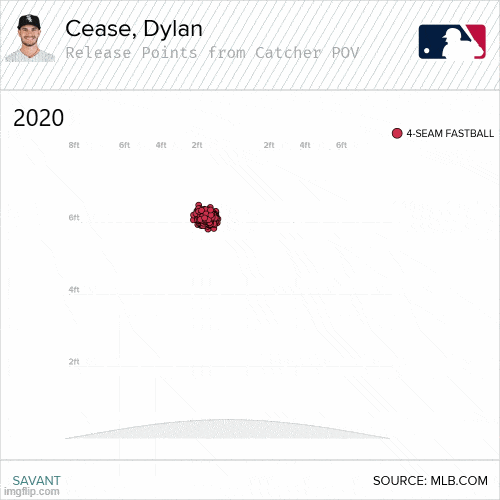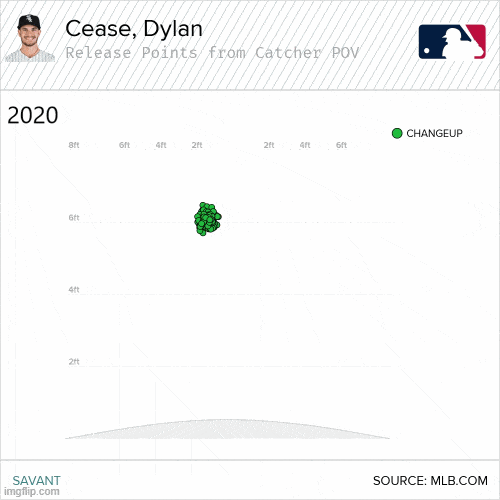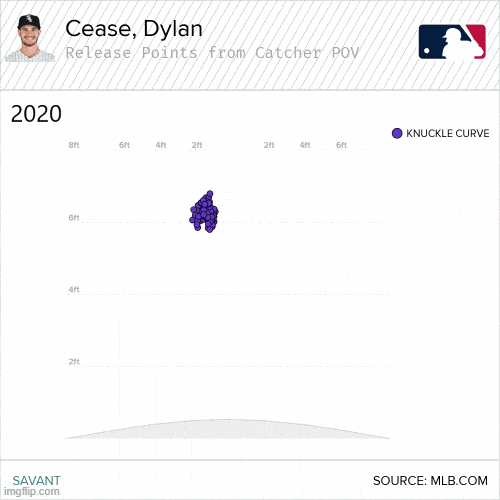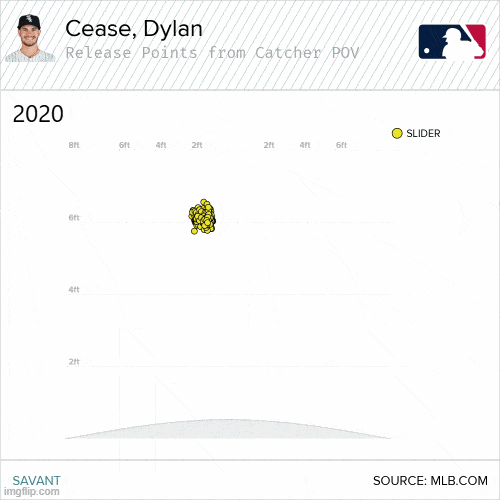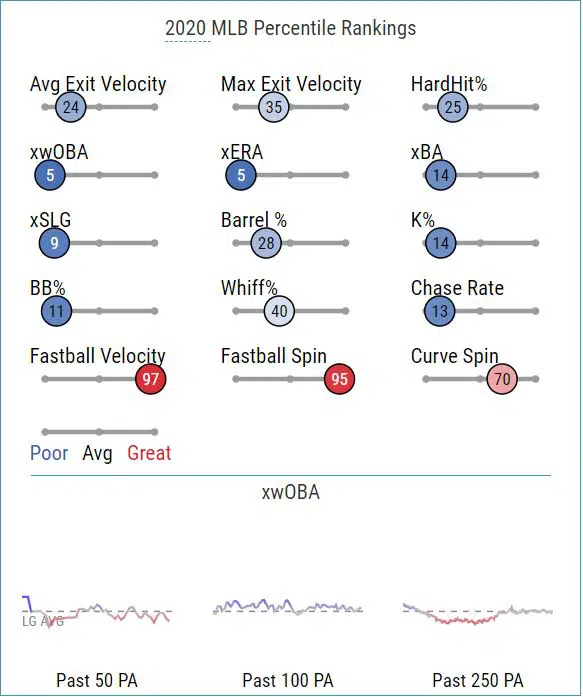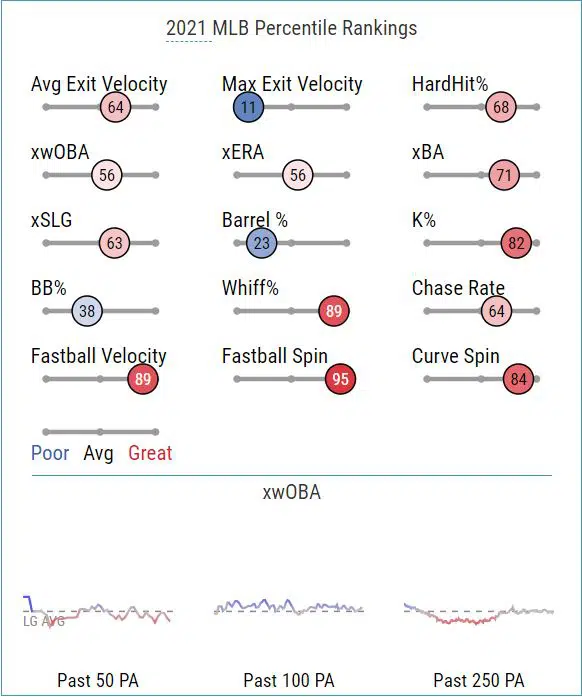When you look at this graphic below, what are your thoughts? What comes to mind?
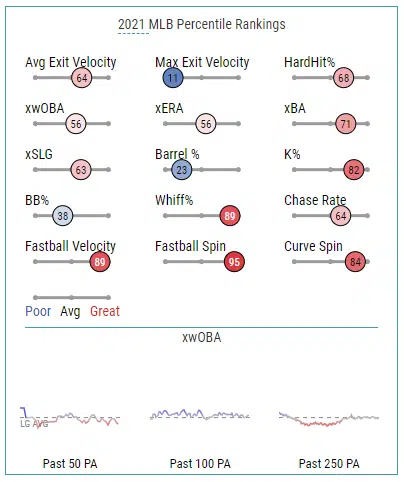
I asked fans on Twitter the same question a few days ago, and their thoughts varied. Some saw a pitcher hurt by the “sticky stuff” ban. Others saw a pitcher with a lot of potential to do well. My thoughts? Well, we will get to those eventually.
Dylan Cease has had a wild ride to start his career. In 2019, he got a nice little stretch in the big leagues across 14 starts and 73 IP. The results weren’t so great, as he had a 5.79 ERA and allowed a .270 average against him.
Then, 2020 came, and the ERA improved! The 4.01 ERA, however, was overshadowed by a decreased strikeout rate (17.3%), an increased walk rate (13.3%), and a FIP (6.36) that resembled someone who had gotten lucky, rather than improved. Things needed to change.
Now, 2021 has arrived. While some look at his pre-2021 numbers and say, “Cease has been in the big leagues for two seasons,” he doesn’t have nearly that much experience – just 26 starts and 130 IP. Now, with 20 starts and 102.2 IP in 2021, Cease is just a few starts away from crossing the threshold of most innings pitched for him in his career at any level.
Just about a year ago, I wrote an article about Cease at the time – a player who was struggling to reach his potential. Now, in 2021, I attempt to answer the same question I asked a year ago:
Exactly who is Dylan Cease, and what is his future on the South Side?
Cease has been a polarizing player among Sox fans. Depending on who you ask, you’ll likely get different opinions about him. Many see untapped potential. Others want him traded as soon as possible.
The undeniable truth is that in 2021, we have seen more growth out of Dylan Cease at the major league level than any season before. While he is clearly still not a finished product, he’s been one of the best pitchers in the league this year – and I’m excited for his future on the South Side.
Don’t believe me? Keep reading.
What Has Changed for Dylan Cease?
1) Mechanics
With any young pitcher, mechanics are likely one of the first things to be scrutinized. Here’s a sampling of two fastballs on the glove side of the plate for Cease – one from 2020 (white jersey) and one from 2021 (black jersey):
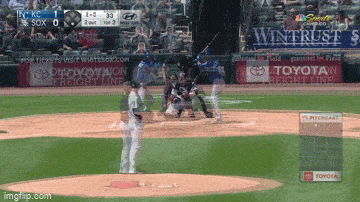
Since I’m not Pitching Ninja, and my video editing skills aren’t great, here are the videos separately too – 2020 on the left.
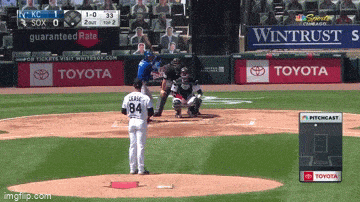
2020 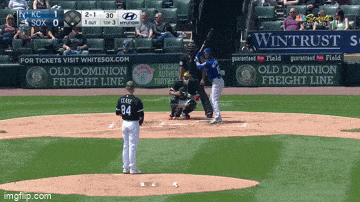
2021
Notice anything? Here are a few things I notice:
- Cease’s motion is more fluid – he works down the mound more quickly without as many slight pauses
- His arm path is shorter and quicker to the plate, likely to help keep him in sync and reduce his tendency to “fly open” and yank the ball to the glove side (as he does in the 2020 video – look where Grandal is set up)
- Cease’s arm is also coming a little more over the top as a result of his shorter arm path
Indeed, we see #2 and #3 when we look at the release point data as well – both at an aggregate level and on a pitch-by-pitch level over the course of two seasons.
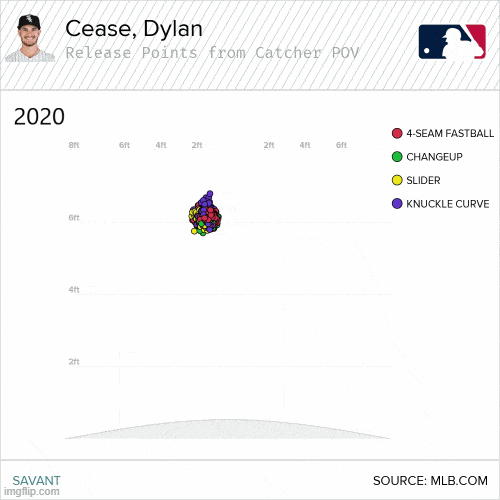
There are a few additional takeaways here:
- Small one, but worth noting – the horizontal shift means Cease likely shifted his placement on the rubber
- VERY IMPORTANT: this season, Cease’s variances in release point have varied more vertically than horizontally. This is important because it points to a more consistent arm path. Vertical variances point to how long a pitcher holds on to the ball.
- The aggregate graph tells the whole story: Cease has been far more consistent both overall and in differentiating between his individual pitches with his release point in 2021.
Why is this important? Because establishing consistent mechanics is one of the most important things for a young pitcher. Consistency allows for rhythm, and rhythm allows pitchers to get into grooves.
But, this is just his mechanics. How have these changes impacted his stuff?
2) Increased Fastball “Life” (Movement)
One of the keys for Dylan Cease heading into 2021 was increasing the vertical movement on his fastball. In laymen’s terms: Dylan Cease might’ve thrown hard last year, but he threw a “flat” fastball. Flat fastballs are easy to hit – and hitters did that to Cease all last year (.383 wOBA / .418 xwOBA). Part of the issue was his command. The other part of it was the spin efficiency on his fastball. In other words, he needed to turn some “gyroscopic spin” into “backspin” – spin that actually contributes to the movement of the ball and gives the “rising” effect everyone talks about.
(Note: for a refresher on the different types of spin, see below:
1) Backspin: grip a four-seam fastball. Mimic the spin that would be created if you threw that ball. That’s backspin.
2) Topspin: grip a curveball. Mimic the spin. That’s topspin.
3) Sidespin: grip a slider. Mimic the spin. That’s sidespin. Sidespin also helps the horizontal movement on a fastball – Reynaldo Lopez likely has a lot of this.
4) Gyroscopic Spin: hard to imagine with a baseball. Think of a perfectly thrown spiral on a football. That type of spin is gyroscopic – a football spins a lot, but none of the spin actually has any effect on the ball’s flight path.)
Last year, approximately 82% of the spin on Dylan Cease’s fastball was contributing to its movement. In other words, he had an 82% spin efficiency rating on his fastball. As a comparison point, Lucas Giolito has 99.2% spin efficiency on his fastball – so there was room for improvement.
In 2021?
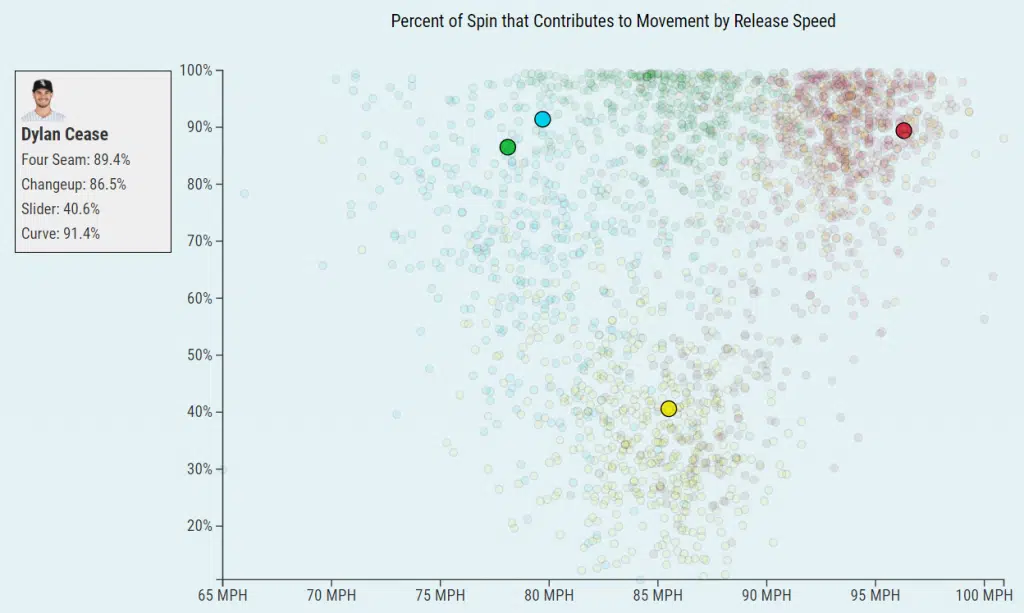
An 8% increase in spin efficiency, up to 89%. Indeed, progress – progress that I believe is, in part, due to a change in mechanics. As Cease has shortened his arm path and raised his release point, he’s given himself the ability to get behind the ball more and create more backspin.
How big of a difference does this increase in spin efficiency actually make? Well, there are two different ways to look at it. The first is looking at the vertical movement on pitches compared to other fastballs around the league year-over-year:
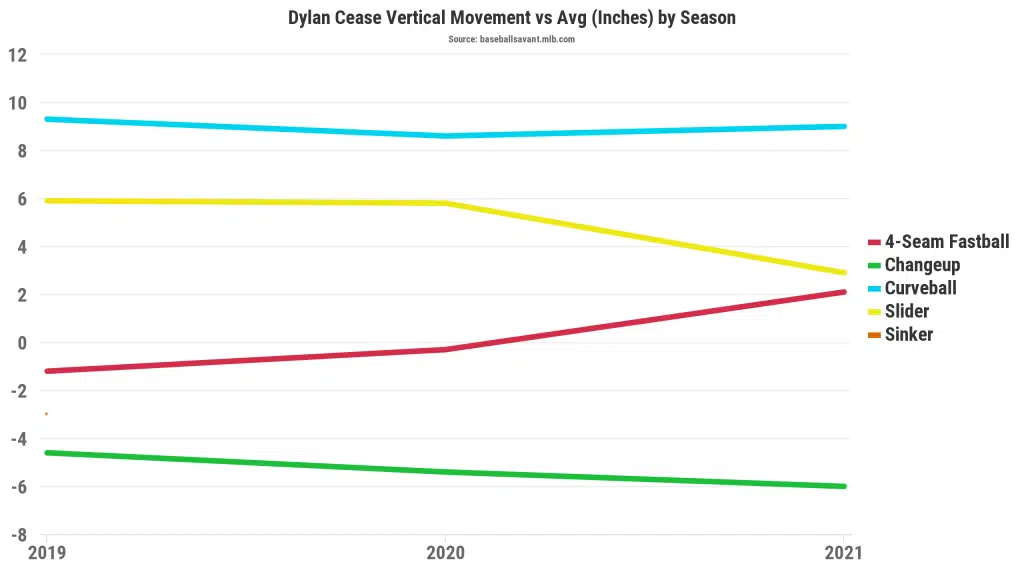
As you can see below, Cease now has two additional inches of movement on his fastball compared to the rest of the league. In percentage terms, that’s 16% more than average in 2021 – compared to 2% below average in 2020. So, the change in spin efficiency has actually resulted in a fastball with more life and “rise”.
The other way is by looking at the results on the fastball specifically:

So, not as great. Better than 2020, but not great. Why is that? We’ll get there later. The important thing to note here is that, in terms of stuff, Cease has improved the quality of his fastball. Another sign of progress.
3) Developing the Changeup into a True Fourth Offering
One of the most interesting developments for Cease in terms of his arsenal has been the improvement of his changeup. Always known as a three-pitch pitcher between his fastball and nasty breaking pitches, a changeup has given Cease the ability to continue to mess with hitters’ timing at the plate.
The .161 wOBA / .156 xwOBA on his changeup this season is a drastic improvement from the .441 wOBA / .452 xwOBA on his changeup in 2020. Part of this improvement has to do with the increased movement on his changeup, as shown below.
The following graph shows the horizontal and vertical movement on each of Cease’s pitches in 2020 (left) and 2021 (right). Notice anything?
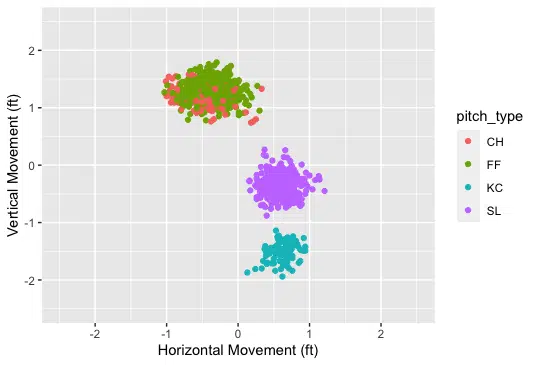
2020 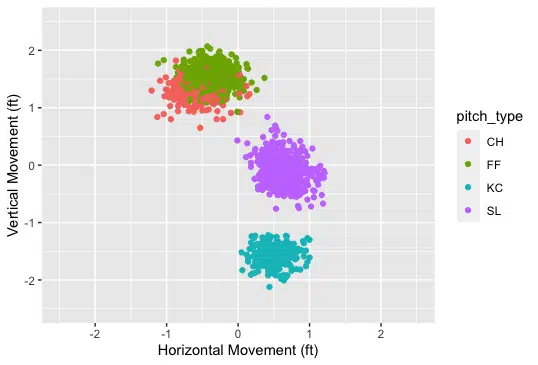
2021
I notice two things:
- Looks as if Cease has gotten more vertical movement on all his pitches (all clusters shifted up)
- Cease has more horizontal movement on his changeup (more separation from his fastball)
Why is #2 so important? Because the movement on a changeup helps keep it distinct timing-wise from a fastball. Even if you fool a hitter with a changeup, if it stays on the same plane as a fastball, hitters are still going to be able to put it in play and do some damage.
Look at the difference between Cease’s 2020 and 2021 changeups below. See how the changeup to Tucker dives away from him far more than the one to Heyward does? That’s the additional horizontal movement (more orange dots to the left) we see in the colorful chart above.
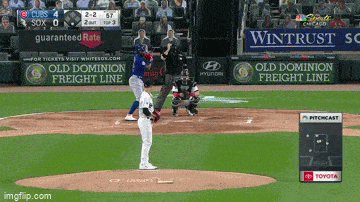
2020 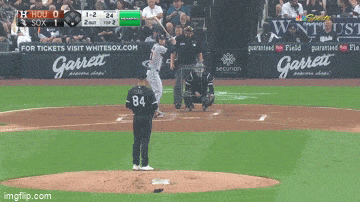
2021
It’s not a stellar out-pitch like it has been for Lucas Giolito, but Dylan Cease has turned it into a legitimate fourth offering. He has taken a few mph off the average speed – from 82.9 mph to 78.1 – and added enough movement to really keep hitters off balance. I’m excited for Cease partially because of what he could be adding here as a fourth pitch.
4) Improve Shape of His Slider/Curveball
This section will be fairly brief because there’s really just one small, but incredibly important, difference with Cease’s breaking pitches. See if you can spot it from the same graphs above:

2020 
2021
It’s slight, but there’s a bit more separation between Cease’s slider and curveball. There’s a bit less horizontal movement on the curveball, and a bit more on the slider, in 2021. All this is meant to show is an improvement upon the shape of Cease’s individual pitches – nothing major, but a sign that he is working to improve all his pitches.
5) Improved Pitch Location and Pitch Consistency
If I asked 10 people, “What does Dylan Cease need to do more consistently,” I guarantee at least nine of them would answer, “Throw more strikes.” I happen to agree with them – a key for Cease heading into 2021 was to get ahead in counts more often to prevent hitters from sitting on his fastball. How has he done with this so far this season? Let’s take a look, pitch-by-pitch.
Fastball
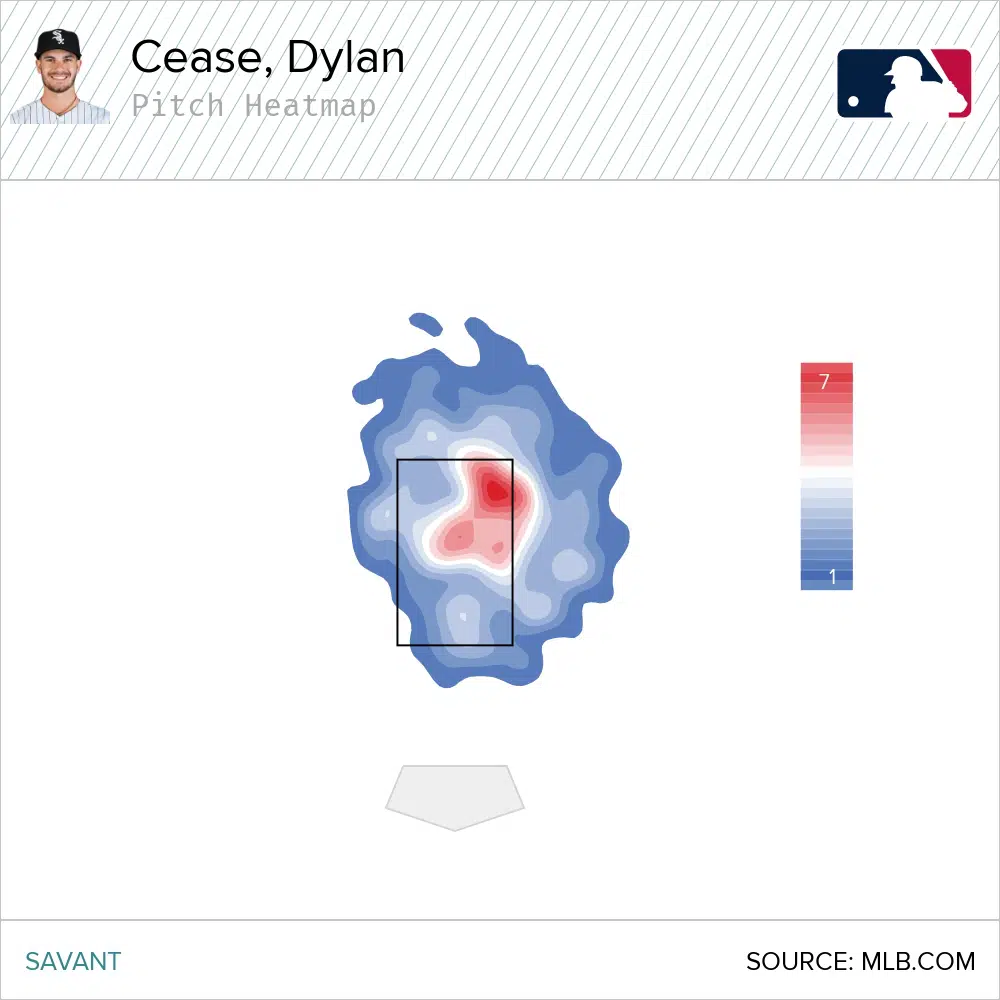
2020 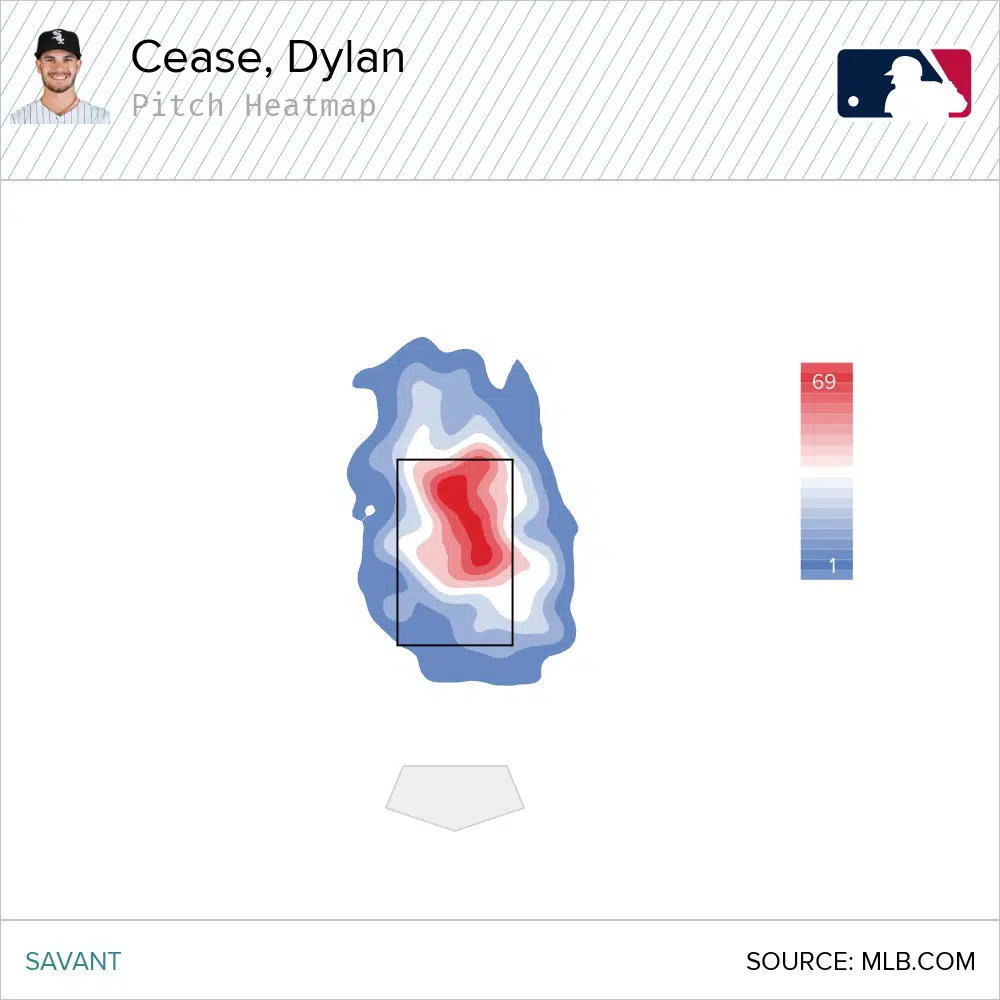
2021
Slider
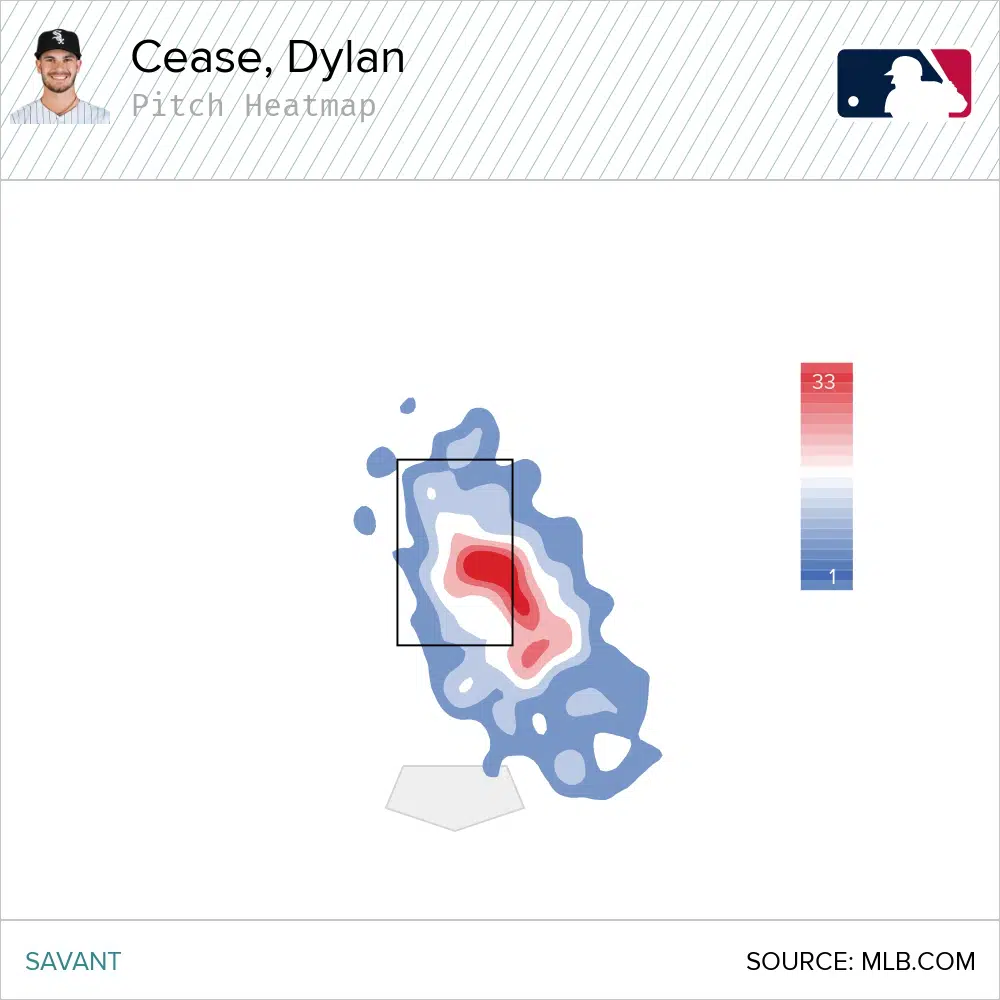
2020 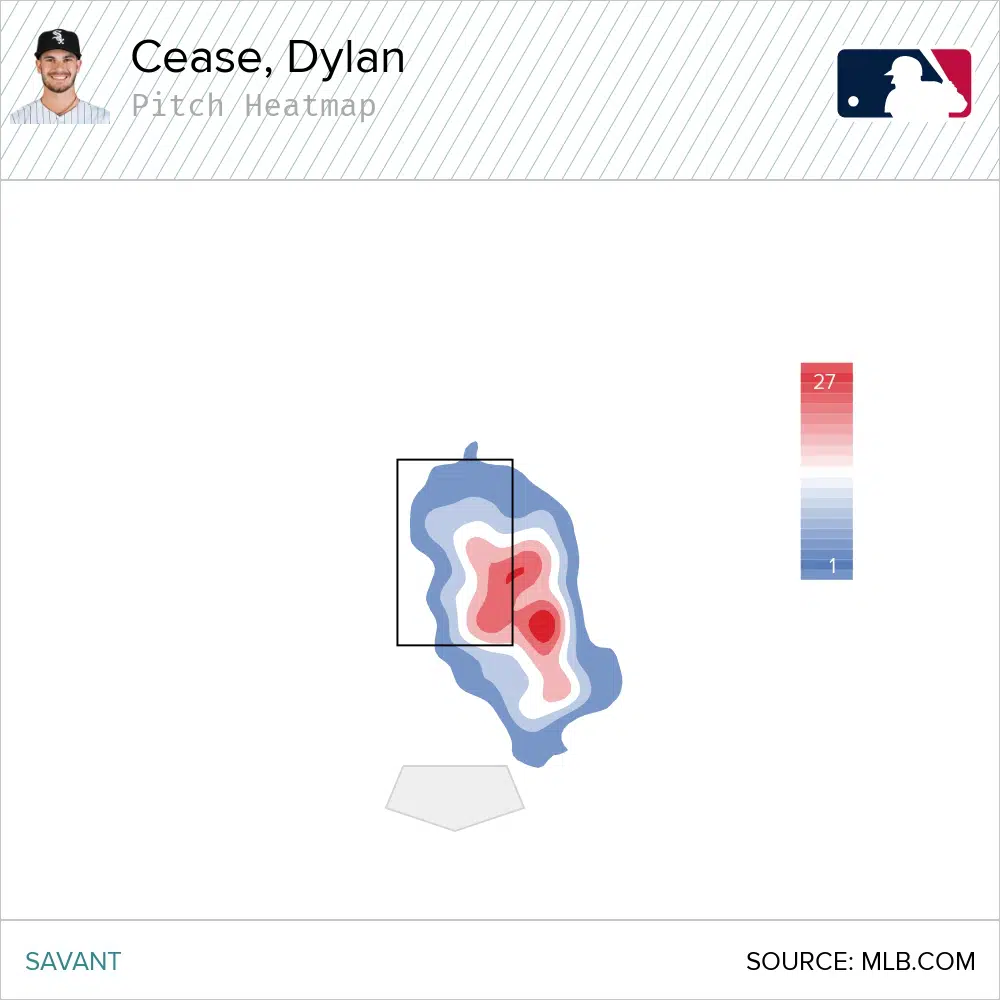
2021
Curveball
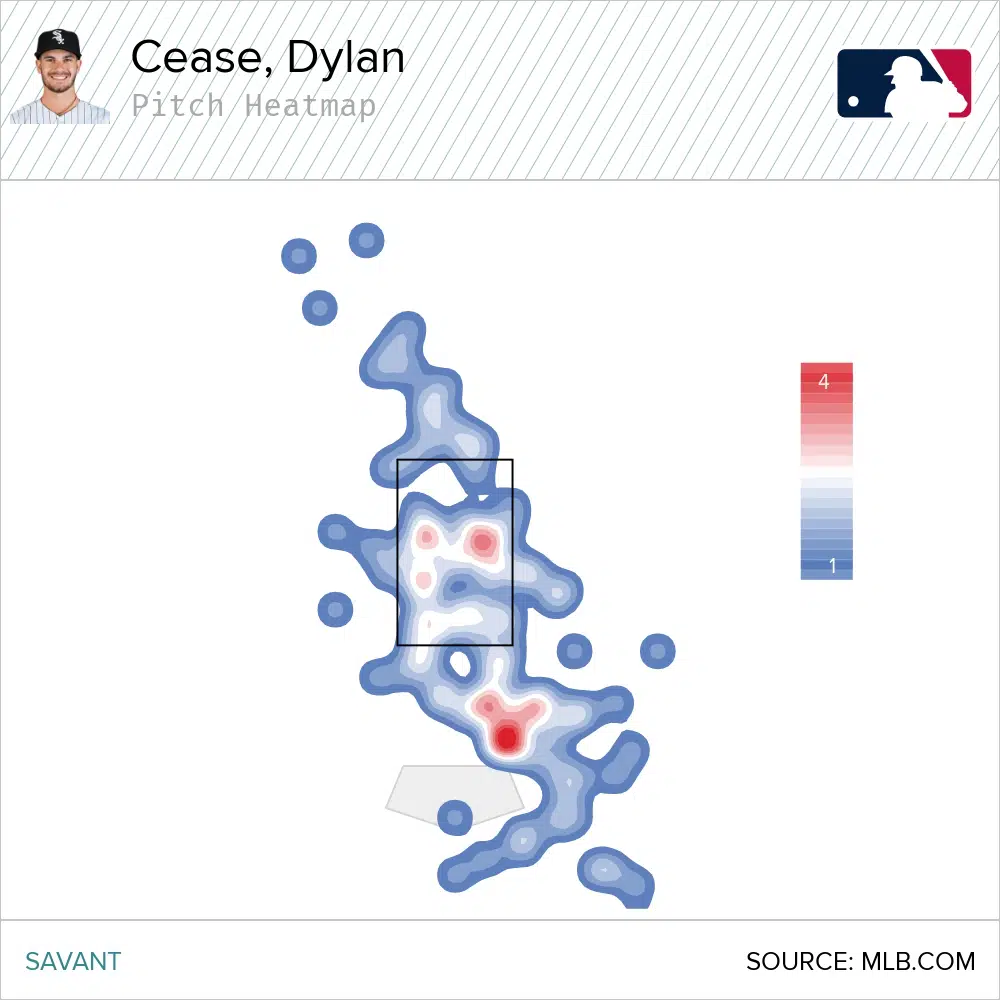
2020 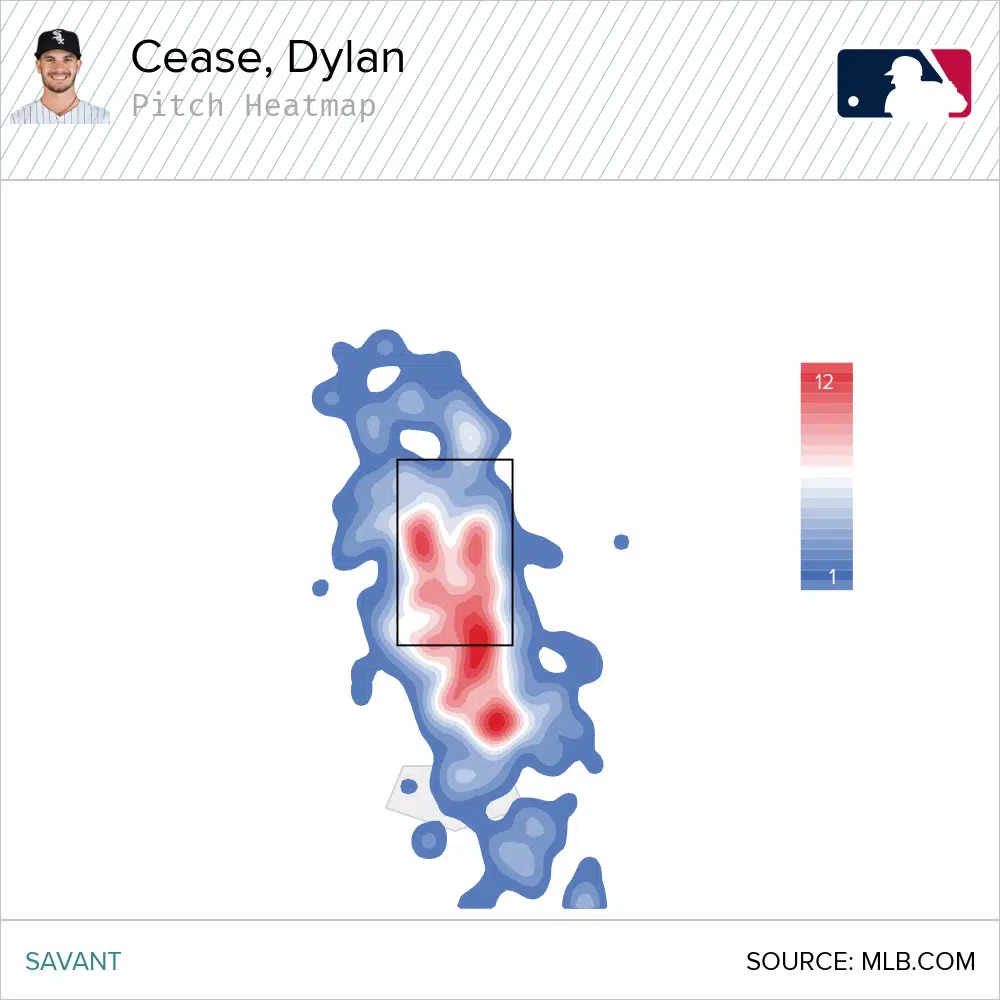
2021
Changeup
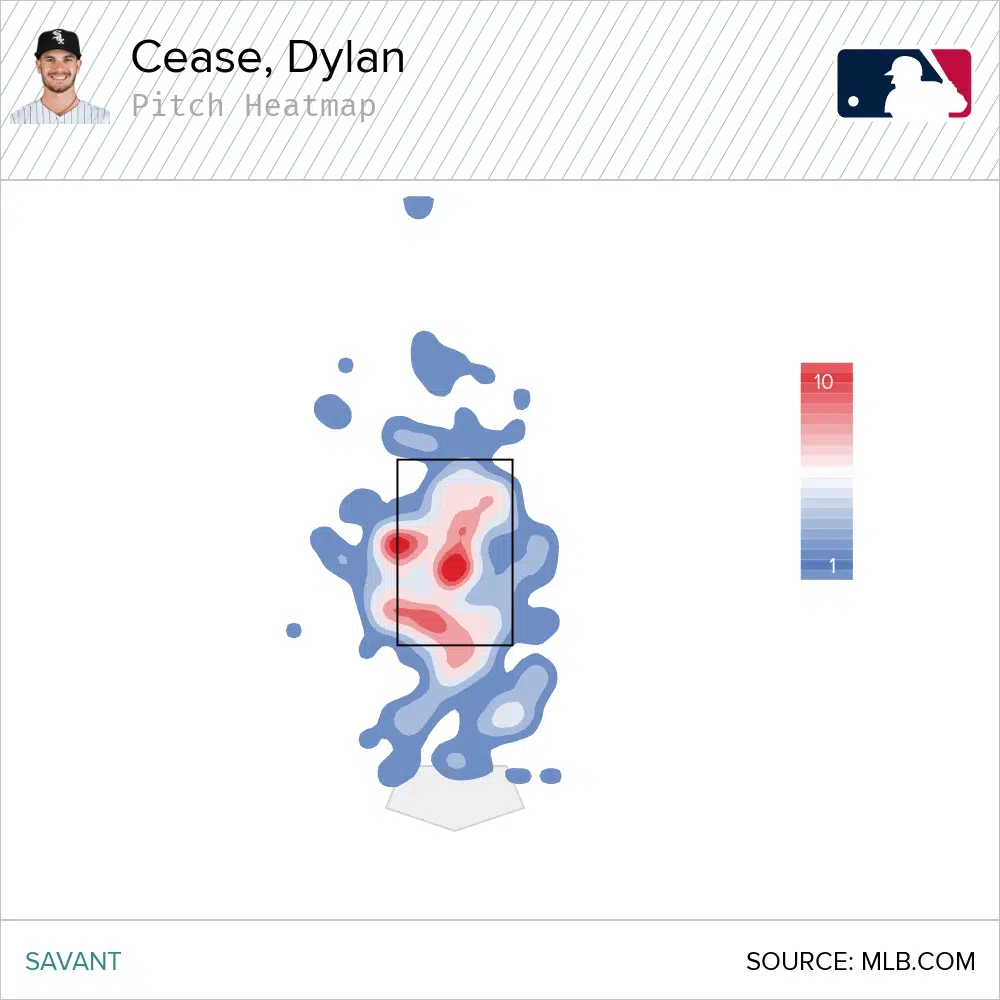
2020 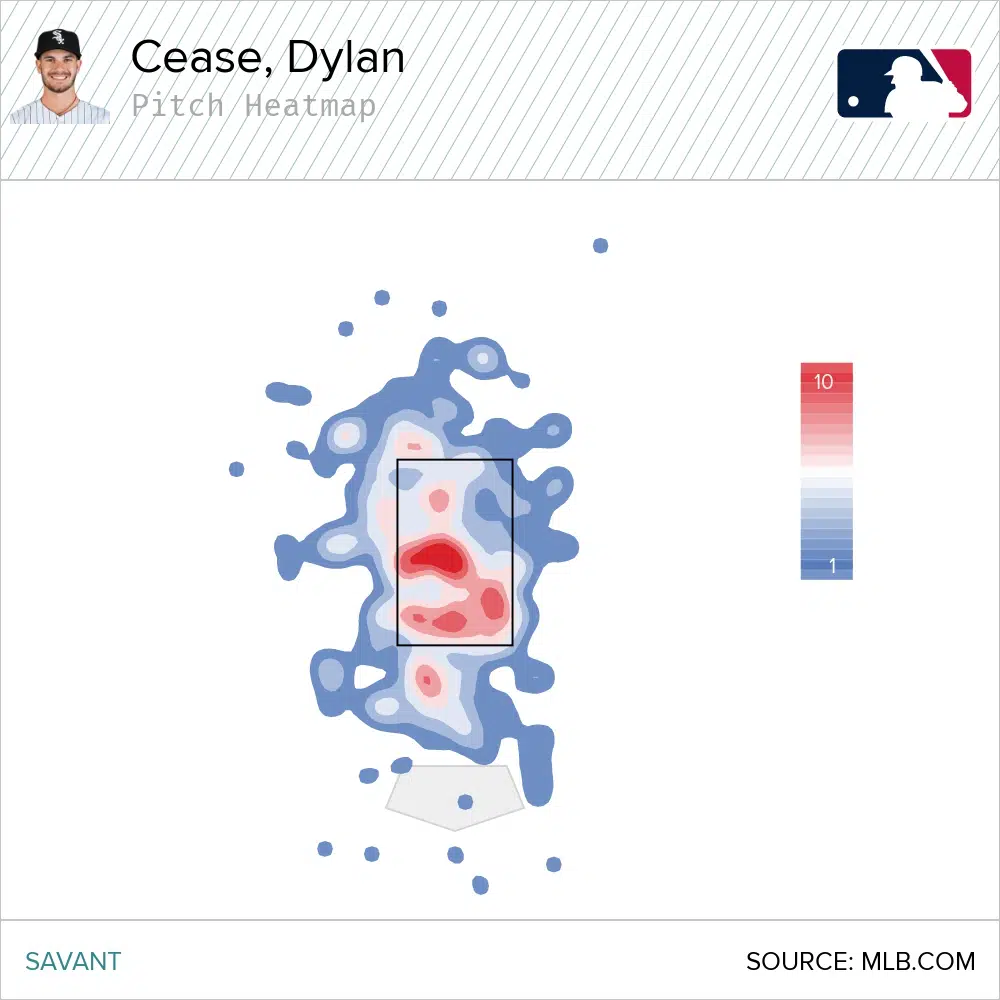
2021
A couple of MAJOR items stick out to me looking at these graphics – the contour maps actually give great takeaways:
- Dylan Cease has a much better idea of where his fastball is going this year – but it still finds the middle of the plate far too often. This likely helps explain some of the stats we saw above regarding hitters’ continued success against his fastball.
- Cease can now not only paint the outside corner with his slider, but he’s able to throw it consistently just off the plate too; this induces A LOT of swing and misses. If hitters think the ball might be on the corner, they’re forced to swing.
- Cease has VASTLY improved the command of his curveball. He can throw it as a get-me-over early in the count, or he can drop it below the zone for some nasty swing-and-misses late in the at-bat.
- Cease’s changeup is only going to continue to get better if he can more consistently locate it at the bottom of the zone.
What’s the importance of consistency like we are seeing above? In a nutshell, it allows Cease to do things like this: tunnel his pitches well and fool hitters into looking for pitchers that aren’t coming. It allows Cease to pitch to his arsenal and command the game.
High fastballs tunnel really welly with curveballs. Truthfully, the improved fastball tunnels well with all of Cease’s pitches, which is why it’s so important he’s begun to control his fastball more. We’ve seen it in starts like the one against Houston recently: when he commands his fastball, he’s going to be unhittable.
There’s still work to be done here – and we will talk about it soon. But, just like the other sections: progress in this key area is clear.
So, Has Any of This Actually Worked?!?
If you’ve watched any White Sox games this season, you likely know the answer to this. However, it’s an incredibly important question.
We’ve gone through a lot so far – let’s recap it quickly:
- Dylan Cease has changed his mechanics to bring more consistency to his arm path
- Increased spin efficiency on Cease’s fastball has given it some of the “life” it was previously missing
- Cease’s changeup is developing into a true fourth offfering – an important thing for any starting pitcher
- In the spirit of continuous improvement, Cease has slightly changed the shape of his slider/cuveball
- Likely thanks to a chance in mechanics, Cease has improved both pitch location and consistency in and around the zone
However, none of this means all that much unless we see some results. Let’s start more detailed, and get more high-level as we go.
We will first go to our last improvement section: pitch location and command. Overall, improved location and consistency have led to the following discipline chart from hitters:

A quick breakdown of the main categories here:
- O-Swing %: the percentage of pitches outside of the zone that hitters swing at
- Z-Swing %: the percentage of pitches inside of the zone that hitters swing at
- O-Contact %: the percentage of pitchers outside of the zone that hitters make contact with
- Z-Contact %: the percentage of pitchers inside of the zone that hitters make contact with
- F-Strike %: the percentage of at-bats that begin with a strike
- SwStr %: Swinging Strike Percentage
There are a couple of awesome takeaways here that really combine pitch location, pitch consistency, and improve pitch movement:
- Hitters are swinging at more pitches out of the zone – and missing more of them too. In other words, Cease is fooling more hitters.
- Hitters are also swinging at more pitches in the zone – and missing more of them as well. In fact, Cease has the 2nd-lowest Z-Contact % in baseball – that is directly related to improve stuff and command.
- You wanted more swinging strikes from Cease, and he’s given them to you at a rate that is 8th in baseball among qualified starters
We also see here one of the crucial improvement areas for Cease: more first-pitch strikes are necessary. He’s improved, but imagine how much better these numbers could be with more strikes early in the count.
Next, we will tackle improved pitch shape and movement. How have Cease’s improved fastball and changeup, as well as his slightly re-shaped curveball and changeup, affected hitters’ ability to make contact with his offerings? We got a sense of it above, but let’s look at it at a pitch-by-pitch level.

Insane jumps across the board – including more swings and misses from the fastball, the big key prior to 2021. Some of those numbers are absolutely crazy – and they show the importance of both improved stuff and improved command.
So far, a lot of good things from Cease. Let’s take a look at a higher level now. Cease is 7-6 on the season with a 4.21 ERA, 3.72 FIP, and 3.89 xERA. So, based on these three numbers, we would say Cease has been pretty solid while showing room for improvement.
Here is where Cease ranks for some other key metrics among qualified starters in all of Major League Baseball:
- K%: 11th (29.5%)
- SwStr%: 8th (14.6%)
- CSW% (Called Strikes + Swing/Miss): 23rd (29.8%)
- Z-Contact%: 2nd (78%)
- xERA: 31st (3.89)
- Hard-Hit%: 17th (35.6%)
- K%-BB%: 21st (19.9%)
Put this all together, and what do you get?
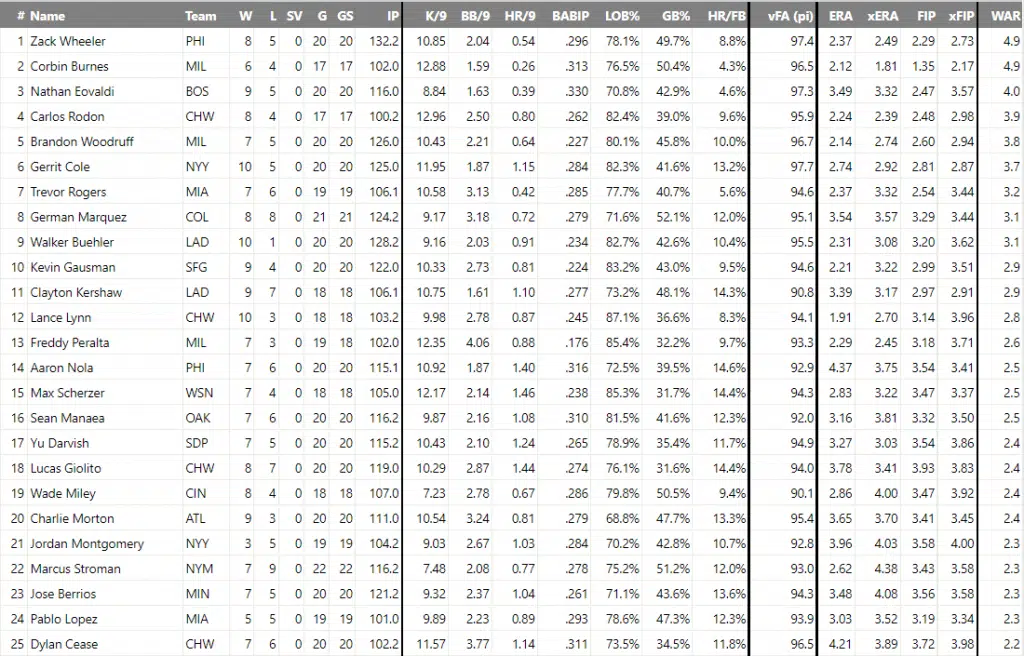
That’s right, a top 25 starting pitcher in baseball this season.
In the company of players such as Jose Berrios, Pablo Lopez, Marcus Stroman, Julio Urias, and Chris Bassitt – guys who are notably not 4/5 starters in their respective rotation.
Yup, Dylan Cease.
The Verdict
I asked the question at the beginning about your thoughts on the graphic that is now on the right. For me, it’s far more important to compare it to the one on the left.
I’m sure you’ve figured it out by now, but both of those graphics are from Dylan Cease’s BaseballSavant page.
When I think about Dylan Cease, I see a pitcher who has made drastic strides forward from his 2019/2020 form. I see a player whose mental makeup needs work but is improving. I see a pitcher who needs to believe his stuff is as good as it is because confidence is key on the mound. As I’ve studied Dylan Cease, I see more and more a pitcher that is on the cusp of being a front-of-the-line starter in this league, and who might just need 10 more starts to capture it. I think every day he spends working with Ethan Katz while being guided by players such as Lance Lynn and Lucas Giolito is an opportunity to get better than he was the previous day.
Dylan Cease’s problem areas are pretty well-laid out. He needs to start hitters off with strikes far more often. When he’s ahead in the count, he needs to make more competitive two-strike pitches and avoid getting too deep into the count. Both of these will allow Cease to work further into ballgames, which is a huge next step for someone with front-of-the-rotation potential. At the same time, I don’t expect every 25-year-old to master these skills with 40 starts in the big leagues – and I think the next 10 this year for Cease will be all the more important as a result.
Being part of a team competing for a title doesn’t afford you much patience from a fan base that wants to see results today, and I can completely understand it. That being said, I’ve never understood the calls to trade Cease or send him to the bullpen, nor have I ever understood some fans’ idea that Cease will never achieve his potential here. Things like that have no basis in what we’ve just walked through in the data. He’s on a 3-4 fWAR pace as the #4 starter in the rotation.
There are 29 teams that would kill to have a player like Dylan Cease – because of that, you have to take a step back and wonder why that’s the case. If 29 other teams want him, shouldn’t you want him too?
Despite all of this writing, we’ve only scratched the surface on Dylan Cease. I’m sure I’ll get to do another one of these next year – but I appreciate you all for sticking around for this one.
If you’re a Cease supporter, I hope I’ve helped teach you something new while making you feel more confident in your support. If you’re a Cease detractor, I hope I’ve at least given you something to think about before you propose your next trade with Cease involved.
Patience is a virtue, and Cease is going to require that as a fan. Based on what I’ve seen, the final product will be worth the wait – and the current product is already better than you think.
Thoughts on Dylan Cease? Drop a comment below or let me know on Twitter @jlazowski14
Featured Photo: NBC Sports Chicago / Twitter

